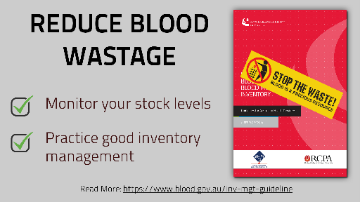We have developed tools and resources to improve and support blood management.
Inventory management guidelines
To help AHPs manage blood product inventory more effectively, we developed the Managing Blood and Blood Product Inventory Guidelines for Australian Health Providers.
These guidelines have support or endorsements from the:
- Australian and New Zealand Society of Blood Transfusion (ANZSBT)
- Royal College of Pathologists of Australasia (RCPA)
- National Association of Testing Authorities, Australia (NATA).
The guidelines are available here:
10 Tips to help manage your blood product inventory
We have also created 10 blood and blood product inventory management tips.
- Understand your inventory
- Provide expert training
- Set appropriate inventory levels
- Keep procedures simple
- Build collaborative relationships
- Use oldest product first
- Optimise crossmatching procedures
- Maintain all equipment appropriately
- Have a plan to conserve inventory in times of shortage
- Have a patient blood management program
Understanding and implementing these tips will help with more effective inventory management.
Cytomegalovirus (CMV) Seronegative Blood Products
With the help of an expert working group, the NBA developed a Position Paper on the Clinical Use of Cytomegalovirus Seronegative Blood Products in Australia. The Patient Blood Management Guidelines advise that only laboratories that provide blood products to paediatric or pregnancy and birth services should hold CMV seronegative inventory.
CMV is a common viral infection that is easily acquired in the community setting and is usually mild and self-limiting, although it can potentially have serious consequences for pregnant women, babies and some immunosuppressed patient groups. CMV can also be transmitted through a blood transfusion.
All Australian cellular blood products (except granulocytes) are leucodepleted (removal of white cells).
National Statement on the Clinical Indications for Apheresis and Whole Blood Pooled Platelets
With the help of an expert working group, the NBA developed a National Statement on the Clinical Indications for Apheresis and Whole Blood Pooled Platelets.
This statement aims help clinicians choose the most appropriate platelet infusion and plan for the future demand trends for platelets.
Clinical indications were reviewed for each type of platelet component based on current evidence and expert opinion considering relevant Patient Blood Management guidelines.
These clinical indications were used in the development of the National Blood Supply Contingency Plan(Opens in a new tab/window) Annex C- Platelet Response Plan.
Case Studies
To help AHPs meet the National Safety and Quality Health Service Blood Management Standard the NBA have developed a range of Better Practice Case Studies. These Case Studies identify different blood management practices already in existence across the country. Other AHPs can adopt and change the relevant approaches to suit their own conditions.
These case studies show one example of an approach that worked for the AHP. You should consider all effects and risks in your hospital or laboratory before implementing.
Single Unit Transfusion
We have developed a guide and resources for implementing single unit transfusion based on the Patient Blood Management Guidelines.
The National Safety and Quality Health Service Blood Management Standard requires blood and blood product policies and procedures to be consistent with national evidence based guidelines. The single unit transfusion guide and resources describes reasons why single unit transfusion is beneficial to patients and includes resources to help you implement it.
Please feel free to adapt, alter and re-badge the single unit transfusion guide and resource material as needed to suit your local area.
Audits
To help AHPs meet the National Safety and Quality Health Service Blood Management Standard the NBA have developed two audit tools.
The Massive Transfusion Protocol Clinical Audit Tool can help you to in identify gaps, measure activity and provide evidence to improving practice related to Massive Haemorrhage Protocols. The Audit Tool has two parts:
The Red Blood Cell Clinical Audit Tool can help you to measure current practice and improve patient outcomes. The collected data can be used to support the audit and monitoring requirements for the organisation. The Audit Tool has two parts:
Posters and other resources
You can also download digital versions of our posters, guidelines and other inventory management resources.

| Download your preferred size and format: |

| Download your preferred size and format: |

| Download your preferred size and format: |

| Download your preferred size and format: |

| Download your preferred size and format: |
Promotional campaign
We have developed a targeted range of wastage-reduction promotional material for clinical staff, including:
- laboratory staff
- transfusion nurses
- clinical champions.
We have designed these materials to move discussions of blood product management from laboratories to clinical areas, such as wards or operating theatres.
To order materials, complete the Stop the Waste Promotional order form email support@blood.gov.au.
Last updated: 24 Sep 2024
